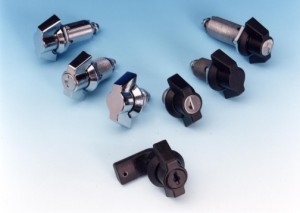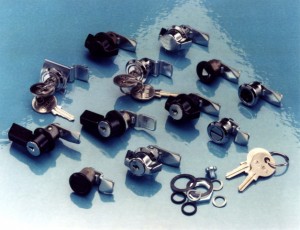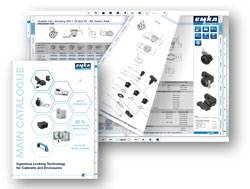By Andy Billingham, Managing Director – EMKA (UK) Ltd
Not so long ago – before EMKA introduced their ¼ turn lock – there were two popular ways of closing small cabinet doors: with a threaded fastener such as a screw, or with an L or T handle which was usually out of proportion, cumbersome and expensive.
 The ¼ turn lock offers a precision alternative with lower cost-of-ownership than the threaded fastener and lower purchase cost than the L/T handle. This same range of needs today drives evolution of the ¼ turn lock, with new materials, new designs and new applications.
The ¼ turn lock offers a precision alternative with lower cost-of-ownership than the threaded fastener and lower purchase cost than the L/T handle. This same range of needs today drives evolution of the ¼ turn lock, with new materials, new designs and new applications.
Threaded fasteners, like screws, self-tappers, nuts and bolts, are initially attractive for their low purchase cost, but are slow to fit, require tools to operate and need very accurate preparation of both halves of material which need to line up. The overall cost of a threaded fastener becomes significantly greater than a ¼ turn lock because there is more cost in preparation and more cost in operation, e.g. locking and unlocking – plus the non-captive elements are easily lost, leading to cabinets being left open. Consequently, we can see that where frequent access is required ¼ turn operation is significantly cheaper.
| ¼ turn | Nut and Bolt |
| 1 punched hole | 2 punched holes |
| 1 nut | not applicable |
| install cage nut (rivet nut/weld nut) | |
| quick ¼ turn action | closure screwdown |
| predetermined compression | No control – poor sealing, door distortiongasket damageopening – time to unscrew |
| Speed of operation can be important, e.g. to reset breaker, to troubleshoot and get production machinery on line quick – an indefinable but significant cost. | |
L & T handles offer the right kind of operation but are simply too large and too expensive for smaller cabinets. They also protrude in a way that is often a problem in this size of enclosure.
Functionally it has been found that small boxes work well with lids having four screws (in each corner), but as the box size goes up there are limitations:
– screws pull down in an unrestricted way leading to possible lid distortion.
– as the size of the enclosure increases then more screws may be needed.
– accuracy of alignment becomes more difficult to achieve.
EMKA ¼ turn locks however are simple assemblies, quickly fitted with a single nut with many advantages:
– they accommodate a good degree of variability in installation.
– being designed as a modular range, users can pick up on a full range of security options, including various IP sealing and key possibilities.
– ¼ turn locks incorporate accuracy of quality manufacturing and consistency of operation.
– the ¼ turn modular design concept allows upgrading to multipoint systems should the application call for it, while still using a single point of operation.
– padlockable and other variants are possible.
How is this achieved – where will it go?
The standard EMKA ¼ turn lock was originally made in zinc die with a roundhead form for easy alignment.  The cylinder has four flats for self-location and a large diameter ISO thread to accept a backnut, which fits over the cam for quick fitting. The cam program is standardised on an optimum length with 3mm leading fold to allow both L or R operation with smooth lead-in and consistent gasket compression.
The cylinder has four flats for self-location and a large diameter ISO thread to accept a backnut, which fits over the cam for quick fitting. The cam program is standardised on an optimum length with 3mm leading fold to allow both L or R operation with smooth lead-in and consistent gasket compression.
This single operation of fitting a fully assembled item in a single punched hole was a great advance over competitors products that used 3-hole fixing and needed assembly on installation, which is still the case today with some manufacturers. Modular design now allows the ¼ turn locking system continued evolution and provides a solid base of manufacturing technology for future development.
OEM requirements can be met with different shapes of escutcheon, different finishes and different materials. Thus design considerations can be accommodated in the shape and style of lock design, as well as a choice of materials such as zinc die and chrome, zinc die and black, epoxy, polyamide, stainless steel. Continuous development is taking us into the area of high-tech materials for applications requiring high strength with low weight – for example titanium being one material recently considered for such an installation.
Download “1/4 turn locks – where did they come from, where are they going?” as a pdf document



